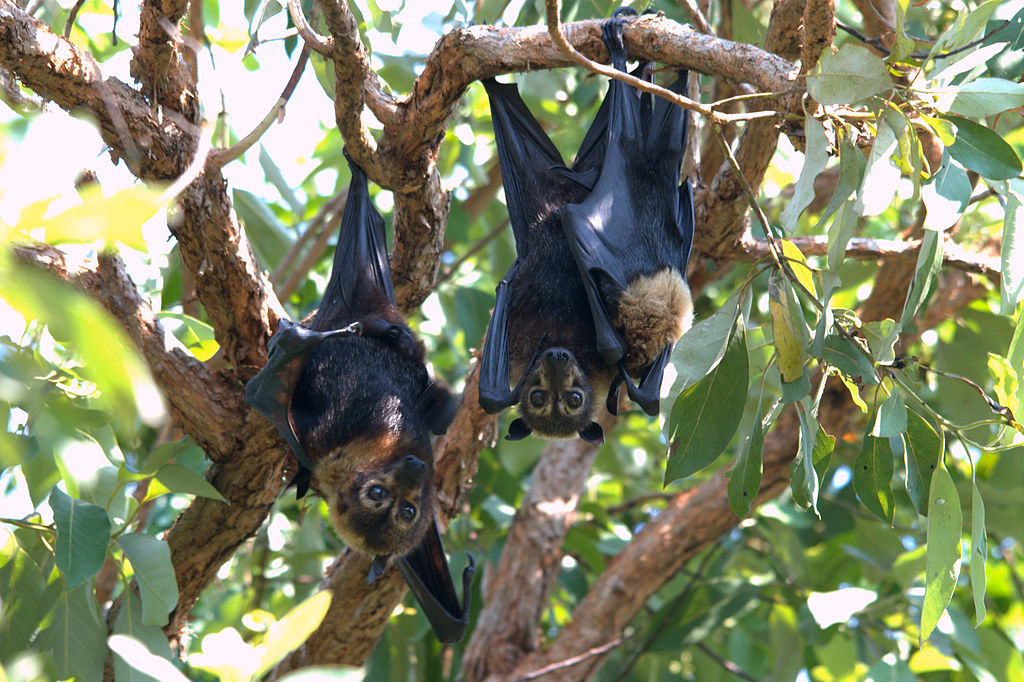Kirstiana Ward, Managing Lawyer of the Cairns EDO office, considers the plight of the endangered Spectacled Flying Foxes, and the ways that national and state environmental laws have failed to offer the large Cairns roost camp protection, with a costly and possibly unsuccessful dispersal attempt approaching.
Spectacled Flying Foxes, listed as endangered under the Environment Protection and Biodiversity Conservation Act 1999 (Cth) (EPBC Act) since February 2019, are a keystone species that move rainforest and other tree seeds from one isolated patch of rainforest to another. They are a significant long distance pollinator of the World Heritage listed Wet Tropics in northeast Queensland. These unique mammals bring great delight to many locals and visitors from around the world as they take flight over Cairns and the Coral Sea every day at dusk.
The EDO has a long history of working with the Cairns and Far North Environment Centre (CAFNEC) and local community groups to protect the species (and by extension, our wet tropics). However, tourism led to development and extensive development led to the Cairns Regional Council regularly using its “as of right” powers under the Queensland Nature Conservation Act 1992. This has allowed Council to remove all but one remaining roost tree for the nationally significant roost camp in the city of Cairns.

Death by a thousand cuts
This death by a thousand cuts destruction of habitat for the Cairns Spectacled Flying Foxes has now ended in Cairns Regional Council receiving approval in May 2020 from the Federal Department of Agriculture, Water and the Environment (DAWE) to implement deterrent measures to disperse and permanently relocate the spectacled flying fox population located at Cairns library.
The controlled action to disperse the camp over five years required approval under the EPBC Act.
The Cairns community fought hard against this approval, with over 1000 submissions made to the Commonwealth Minister of Environment. There was some hope the dispersal would not be approved given the disastrous heat events of November 2018 which saw over one third of the population die from heat-related stresses and the subsequent uplifting of the species protection status (from vulnerable to endangered) at both State and Commonwealth levels. While the species has a recovery management plan, that is over nine years old and doesn’t consider the current impacts or past cumulative impacts that have led to the destruction of the Cairns City camps’ habitat.
Failure of the EPBC Act
Lucy Graham, Director of CAFNEC, has reiterated how Australia’s leading environmental laws are continually failing our protected species, stating “The EPBC Act has failed to protect the Spectacled Flying Fox and we are seeing unchecked rapid decline of the species in Australia. The failure of the Act to consider cumulative impacts and the slow and unresponsive nature of threatened species listings has resulted in devastatingly poor management of a keystone species and pollinator for the Wet Tropics World Heritage Area.”
EDO has provided both legal and scientific advice to our clients regarding the approval decision made under sections 130(1) and 133(1) of the EPBC Act. Our clients have no merits appeals rights to challenge approval for a significant impact on threatened species decision under sections S130 and 133 of the Act, which means the only path forward would be Judicial Review. Judicial Review is a very technical legal approach and not the optimum approach in this instance.
If merits appeal rights were available under the Act, our community would have had the opportunity to have their science-based concerns heard in court. The dispersal of flying-fox species camps should be considered a management action of last resort under the Flying Fox Management Guidelines. Camp dispersal has been demonstrated to be both often unsuccessful and costly.[1] The Cairns community will be paying a fiscal price as well as an environmental cost for the attempted dispersal during the next five years. No-one knows where the camp may go. Although the CRC Flying Fox Relocation Implementation Plan has designated habitat found in the Cairns Swamp, scientists suggest this habitat, although once used, is not currently desirable for the species.





